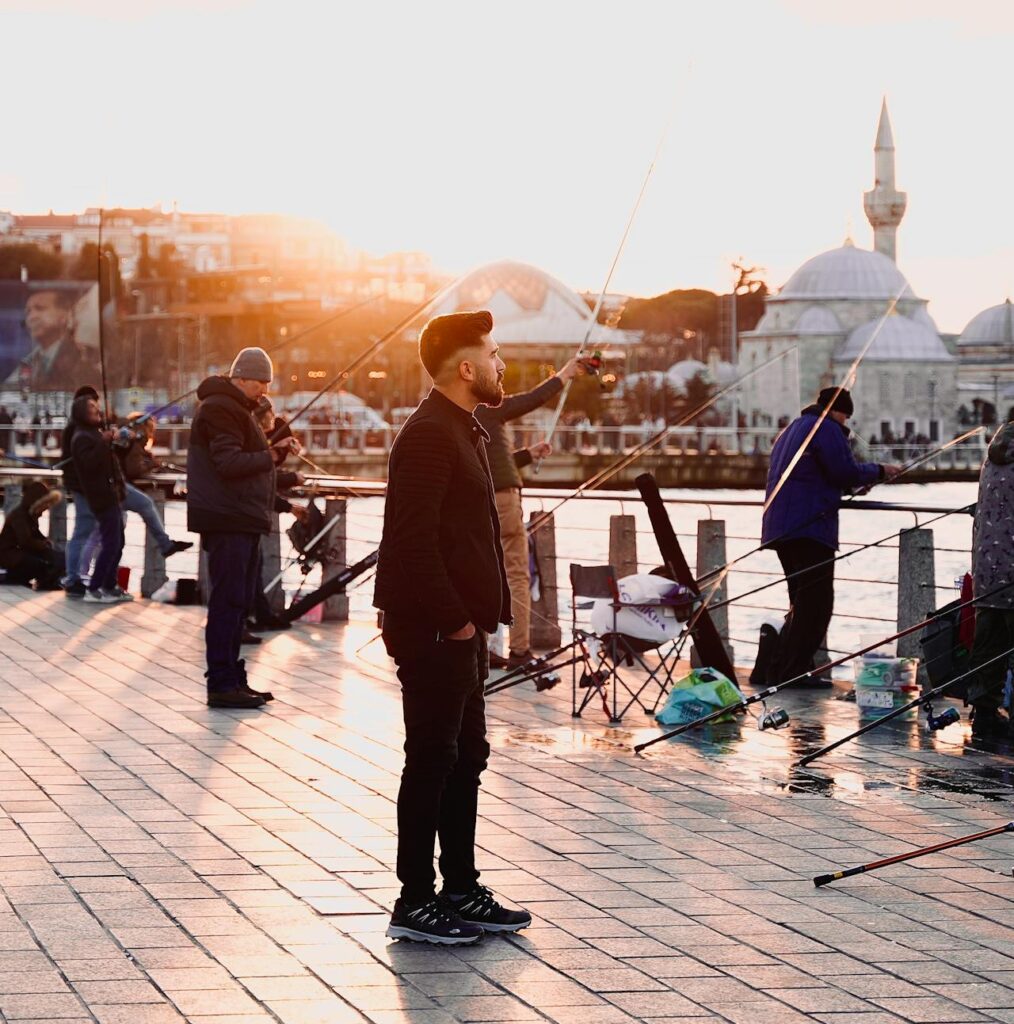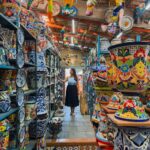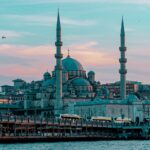Istanbul stands as a magnificent bridge between Europe and Asia, both geographically and culturally. This sprawling metropolis captivates visitors with its extraordinary blend of Byzantine and Ottoman heritage, vibrant neighborhoods, world-class cuisine, and the constant hum of activity along the shimmering Bosphorus strait. For first-time visitors, Istanbul can seem overwhelming—a dazzling maze of minarets, markets, and millennia of history. This comprehensive guide will help you navigate this enchanting city with confidence, ensuring your first visit to Istanbul becomes an unforgettable journey.
What Makes Istanbul Special
Istanbul is unique among the world’s great cities. Where else can you start your morning in Europe and have lunch in Asia without boarding a plane? The city that was once Constantinople—capital of the Byzantine and Ottoman Empires—carries its imperial legacy in magnificent monuments like the Hagia Sophia and Topkapi Palace. Yet Istanbul is no museum piece; it’s a dynamic, ever-evolving metropolis where tradition and modernity dance together on streets where merchants have traded for centuries.
The city’s strategic position on the Bosphorus strait has made it a crossroads of civilizations for over 2,500 years. This rich history has created a cultural tapestry that continues to unfold before visitors’ eyes—from the call to prayer echoing across rooftops to contemporary art galleries and pulsing nightlife. Istanbul doesn’t just bridge continents; it connects past and present in a way few other destinations can match.
When to Visit Istanbul
Istanbul enjoys a temperate climate with four distinct seasons, each offering a different perspective on the city:
Spring (April-May)
Spring brings mild temperatures (15-25°C/59-77°F) and the spectacular Istanbul Tulip Festival, when millions of tulips bloom across the city’s parks. This is an ideal time to visit, with comfortable weather for sightseeing and fewer crowds than summer.
Summer (June-August)
Summers are hot and humid (25-32°C/77-90°F), with peak tourist crowds. While this means longer lines at major attractions, summer also brings vibrant street life, rooftop dining with spectacular views, and the perfect weather for Bosphorus cruises.
Fall (September-November)
Like spring, autumn offers pleasant temperatures and thinner crowds. The city takes on a golden hue as leaves change color in parks like Gülhane and Yıldız. Early fall is particularly lovely, with warm days and cool evenings perfect for exploring.
Winter (December-March)
Winters are cold and sometimes rainy or snowy (5-10°C/41-50°F), but the city rarely experiences extreme cold. This is low season, meaning better hotel rates and fewer tourists at major sites. The occasional snowfall transforms Istanbul into a magical winter wonderland, especially around the Blue Mosque and Hagia Sophia.
Our recommendation: For the ideal balance of pleasant weather, reasonable crowds, and full access to attractions, plan your visit during mid-April to early June or September to October.
Essential Planning Information
Visa Requirements
Many visitors to Turkey require a visa, though requirements vary by nationality. Most tourists can obtain an e-visa online before arrival through the official Republic of Turkey e-Visa website. The process is straightforward, typically costing around $50 USD for most nationalities. Always check the latest requirements well before your trip, as regulations can change.
Currency
Turkey uses the Turkish Lira (TRY). While major credit cards are widely accepted in hotels, restaurants, and larger shops, having cash is essential for small purchases, markets, and some local establishments. ATMs are abundant throughout tourist areas. We recommend withdrawing lira as needed rather than exchanging large amounts of cash, as exchange rates at ATMs are generally better than at currency exchange offices.
Language
Turkish is the official language, but English is widely spoken in tourist areas, hotels, and restaurants. Learning a few basic Turkish phrases will enhance your experience and is appreciated by locals:
- Merhaba (mehr-ha-ba) – Hello
- Teşekkür ederim (teh-shek-kur eh-der-im) – Thank you
- Lütfen (loot-fen) – Please
- Evet/Hayır (eh-vet/hai-uhr) – Yes/No
Safety
Istanbul is generally safe for tourists, with violent crime rates lower than many European and American cities. The main concerns are pickpocketing and scams in crowded tourist areas. Exercise normal precautions:
- Keep valuables secure and be aware of your surroundings
- Use official taxis or transportation apps
- Be wary of overly friendly strangers offering unsolicited help or “special deals”
- Respect local customs, particularly when visiting religious sites
Getting to Istanbul
By Air
Most international visitors arrive at Istanbul Airport (IST), which replaced the old Atatürk Airport in 2019. This massive, modern facility serves as Turkish Airlines’ hub and handles flights from across the globe. Sabiha Gökçen Airport (SAW) on the Asian side primarily serves budget and domestic carriers.
From Istanbul Airport to the city center:
•Havaist Airport Shuttles: Comfortable buses running to various city destinations (45-60 minutes depending on traffic, approximately 30 TL)
•Taxi: More expensive but convenient (45-60 minutes, 350-450 TL depending on your destination)
•Public Transportation: Metro line M11 connects to the main public transit network (allow 90+ minutes to reach central areas)
By Train
International train services to Istanbul are limited but include routes from Sofia, Bulgaria and Bucharest, Romania arriving at Halkalı station on the European side.
By Bus
Long-distance buses connect Istanbul to destinations throughout Turkey and neighboring countries. Most international and intercity buses arrive at the Istanbul Bus Station (Esenler Otogarı), from where you can take the metro into the city center.
Getting Around Istanbul
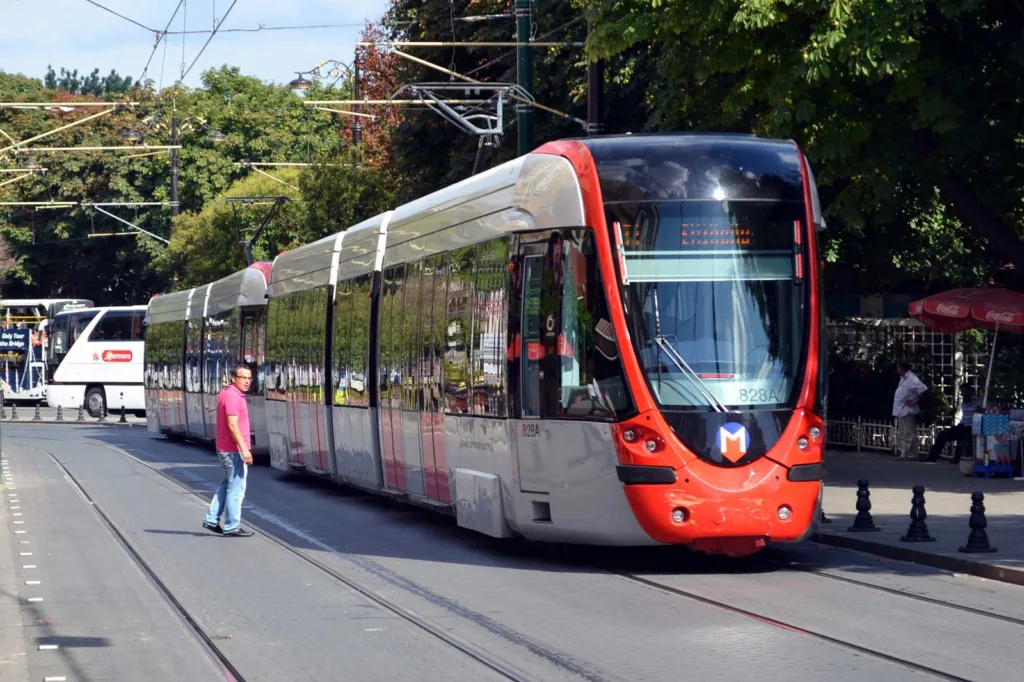
Public Transportation
Istanbul’s public transportation network is extensive and affordable:
- Istanbul Card (Istanbulkart): This reloadable card is essential for using public transit. Purchase one at major transit stations or authorized vendors (initial card cost around 25 TL plus whatever balance you add).
- Metro: Clean, efficient, and the fastest way to travel longer distances. The network continues to expand but doesn’t reach all tourist areas.
- Tram: Ideal for tourists, as lines T1 and T5 connect many major attractions in the historical peninsula and beyond.
- Buses: Extensive network reaching virtually every corner of the city, though they can be confusing for first-time visitors and are subject to traffic congestion.
- Ferries: Not just transportation but an essential Istanbul experience. Regular ferries connect European and Asian shores, offering spectacular views of the city skyline
- Funiculars: Short automated rail lines that help navigate Istanbul’s steep hills, including the historic Tünel (the second-oldest underground urban rail line in the world) and the Karaköy-Beyoğlu funicular.
Taxis and Ridesharing
Yellow taxis are plentiful in Istanbul. Always ensure the meter is running (starting fare around 15 TL) and have your destination written in Turkish if possible. BiTaksi and iTaksi are reliable local taxi apps. Uber also operates in Istanbul, though it works by connecting you with licensed taxis rather than private drivers.
Walking
Many of Istanbul’s historic areas are best explored on foot. The Sultanahmet district (old city) is particularly walkable, with many major attractions clustered together. Be prepared for hills and cobblestone streets—comfortable shoes are essential.
Where to Stay in Istanbul
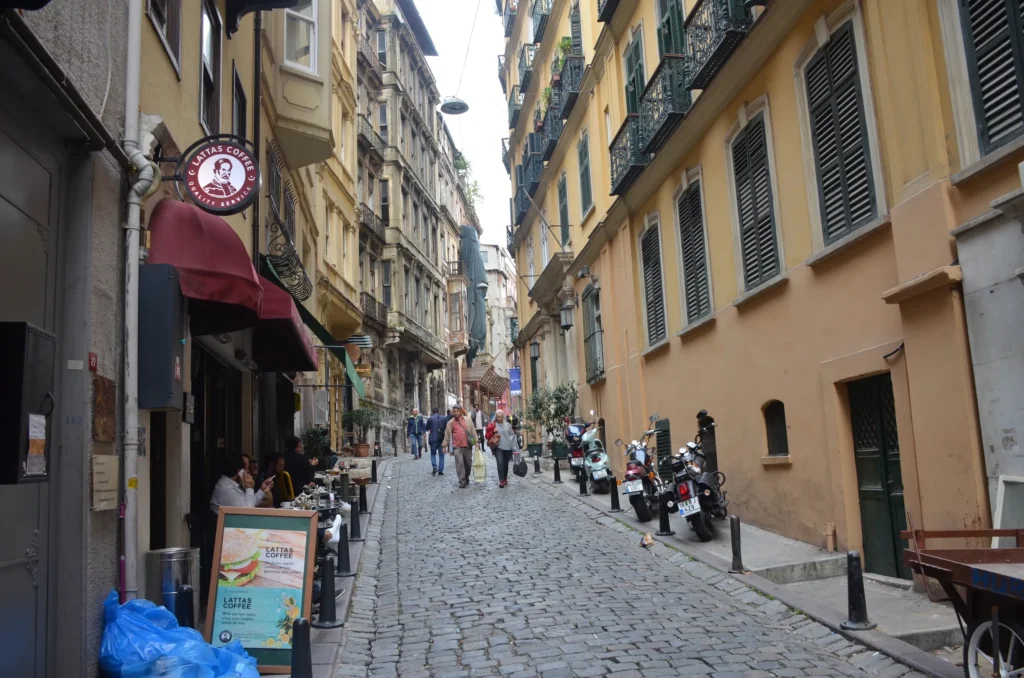
Istanbul offers accommodation for every budget and preference. Your choice of neighborhood will significantly impact your experience. For a detailed breakdown of each area’s character and suitable accommodation options, see our comprehensive guide on “Where to Stay in Istanbul: Neighborhood Guide for Every Type of Traveler“.
Here’s a quick overview of the main areas to consider:
Sultanahmet (Old City)
Best for: First-time visitors focused on historical sightseeing Pros: Walking distance to major attractions like Hagia Sophia and Blue Mosque Cons: Quieter at night, more touristy, fewer local dining options Price Range: Mid to high
Beyoğlu (including Taksim, Galata, Karaköy)
Best for: Urban explorers who want to experience contemporary Istanbul Pros: Vibrant nightlife, excellent dining, art galleries, shopping Cons: Further from historical sites, can be noisy Price Range: Budget to luxury
Beşiktaş and Nişantaşı
Best for: Upscale experience, shopping enthusiasts Pros: Elegant neighborhoods, designer boutiques, fine dining Cons: Higher prices, distance from major attractions Price Range: Mid to luxury
Kadıköy and Üsküdar (Asian Side)
Best for: Experiencing local life away from tourist crowds Pros: Authentic neighborhoods, great food scene, lower prices Cons: Requires ferry/transit to reach European side attractions Price Range: Budget to mid-range
Must-See Attractions in Istanbul
Istanbul’s rich history has left it with an extraordinary collection of monuments and museums. While you could spend weeks exploring them all, these are the essential sights no first-time visitor should miss:
Hagia Sophia (Ayasofya)
Once a Byzantine cathedral, then an Ottoman mosque, later a museum, and now a functioning mosque again, the 1,500-year-old Hagia Sophia stands as one of the world’s greatest architectural achievements. Its massive dome and glittering mosaics testify to Istanbul’s layered history.
Visiting tips: As an active mosque, visitors must dress modestly and women must cover their hair (scarves available at entrance). Closed to tourists during prayer times. No entrance fee.
Blue Mosque (Sultan Ahmed Mosque)
With its six minarets and cascading domes, the early 17th-century Blue Mosque is one of Istanbul’s most photogenic monuments. The interior features more than 20,000 handmade ceramic tiles and 200+ stained glass windows.
Visiting tips: Active mosque with same dress requirements as Hagia Sophia. Expect to queue during peak season. No entrance fee.
Topkapı Palace
Home to Ottoman sultans for nearly 400 years, this sprawling complex offers glimpses into imperial life through its lavish pavilions, courtyards, and collections—including the 86-carat Spoonmaker’s Diamond and sacred Islamic relics.
Visiting tips: Purchase tickets online to avoid queues. The Harem requires a separate ticket but is well worth visiting. Allow at least half a day.
Grand Bazaar
One of the world’s oldest and largest covered markets, with over 4,000 shops spread across 61 streets. Whether you’re shopping for carpets, ceramics, jewelry, or just soaking up the atmosphere, the Grand Bazaar is an essential Istanbul experience.
Visiting tips: Expect to get lost—it’s part of the experience. Bargaining is expected but keep it respectful. Closed on Sundays.
Basilica Cistern
This subterranean wonder, built by Emperor Justinian in the 6th century, features 336 marble columns rising from water-filled chambers. The atmospheric lighting and classical music create an otherworldly experience.
Visiting tips: Recently reopened after extensive renovations. Can provide a cool respite on hot summer days.
Bosphorus Cruise
Seeing Istanbul from the water offers a perspective you can’t get any other way. Options range from expensive private yacht charters to affordable public ferries.
Bosphorus Cruise and Boat Tours in IstanbulVisiting tips: For a budget-friendly option, take the regular commuter ferry to Üsküdar or the longer public Bosphorus tour to Anadolu Kavağı. For a more luxurious experience with dinner and entertainment, consider a private Bosphorus cruise.
Süleymaniye Mosque
Designed by the legendary Ottoman architect Sinan, this 16th-century mosque complex offers spectacular views over the city and Bosphorus from its elevated position.
Visiting tips: Less crowded than the Blue Mosque but equally impressive. The surrounding complex includes a soup kitchen now serving as a restaurant.
Istanbul Archaeological Museums
Three museums in one complex housing over one million artifacts from various civilizations, including the Alexander Sarcophagus and the world’s oldest peace treaty.
Visiting tips: Often overlooked by first-time visitors but houses world-class collections. Located near Topkapı Palace.
Experiencing Istanbul Beyond the Monuments
While Istanbul’s monuments are magnificent, the city’s soul lies in experiences that engage all your senses:
Turkish Cuisine
Istanbul offers one of the world’s great culinary scenes, from street food to fine dining:
- Street Food: Try simit (sesame-encrusted bread rings), roasted chestnuts, grilled fish sandwiches by the Galata Bridge, and döner kebab
- Meyhanes: Traditional taverns serving meze (small plates) and rakı (anise-flavored spirit)
- Lokantalar: No-frills eateries serving home-style Turkish dishes
- Seafood: Especially along the Bosphorus and in Kadıköy
- Sweets: Baklava, Turkish delight (lokum), and künefe
Don’t miss the chance to experience a traditional Turkish breakfast (kahvaltı)—a lavish spread of cheeses, olives, honey, jams, and eggs that will fuel a full day of exploration.
Hammam Experience
The Turkish bath ritual dates back centuries and remains an integral part of the culture. Traditional hammams offer a unique combination of relaxation, cleansing, and cultural immersion.
Recommended hammams for tourists:
•Çemberlitaş Hamamı (historic, centrally located)
•Kılıç Ali Paşa Hamamı (beautifully restored 16th-century hammam)
•Ayasofya Hürrem Sultan Hamamı (luxurious option near Hagia Sophia)
Shopping Beyond the Grand Bazaar
While the Grand Bazaar is a must-visit, Istanbul offers diverse shopping experiences:
- Spice Bazaar (Egyptian Bazaar): Aromatic spices, Turkish delight, and other culinary treasures
- İstiklal Avenue: Modern shopping street with international and Turkish brands
- Çukurcuma: Antique shops and vintage stores
- Nişantaşı: Luxury boutiques and designer stores
- Kadıköy and Moda: Independent shops and local designers
Neighborhoods to Explore
Each Istanbul neighborhood has its own character:
- Balat: Colorful houses, hipster cafes, and Jewish heritage
- Karaköy: Transformed docklands with trendy cafes and art galleries
- Kadıköy: Vibrant market and food scene on the Asian side
- Ortaköy: Charming waterfront area famous for its mosque and weekend market
- Beyoğlu: Historic yet contemporary district with excellent nightlife
If you have limited time in Istanbul, our “Istanbul in 3 Days: The Perfect Weekend Itinerary” offers an efficient route to experience the city’s highlights.
Practical Tips for First-Time Visitors
Cultural Etiquette
- Dress modestly when visiting mosques (covered shoulders and knees; headscarves for women)
- Remove shoes before entering mosques (bags are provided)
- Ask permission before photographing locals
- Public displays of affection should be minimal
- Pointing the sole of your foot at someone is considered rude
Money-Saving Tips
- Consider the Museum Pass Istanbul for multiple attractions
- Use public transportation instead of taxis when possible
- Eat where locals eat—prices drop significantly away from tourist areas
- Bargain at bazaars but know when to stop—the goal is a fair price, not the absolute lowest
- Tap water is generally safe but most visitors and locals prefer bottled water
Connectivity
Wi-Fi is widely available in hotels, cafes, and restaurants. For constant connectivity, purchase a local SIM card (available at the airport or from mobile shops in the city) or rent a portable Wi-Fi device.
Avoiding Common Scams
- Shoe-shiners who “accidentally” drop their brush (expect to pay if you help)
- Friendly strangers inviting you to a bar (often leading to overpriced drinks)
- Taxi drivers taking long routes (use navigation apps to monitor your journey)
- “This attraction is closed today” approaches (verify opening hours independently)
Day Trips from Istanbul
If you have extra time, consider these rewarding excursions:
Princes’ Islands
Car-free islands in the Sea of Marmara accessible by ferry. Büyükada, the largest, offers Victorian architecture, pine forests, and horse-drawn carriages.
Bursa
The first Ottoman capital, famous for its thermal baths, silk market, and the birth of the Turkish kebab. Accessible by ferry and bus or organized tour.
Edirne
Near the Bulgarian border, this former Ottoman capital boasts the magnificent Selimiye Mosque, considered architect Sinan’s masterpiece.
Gallipoli Peninsula
Site of the WWI campaign, now a moving memorial park. Best visited as an overnight trip.
Final Thoughts
Istanbul defies easy categorization—it’s a city that must be experienced rather than simply visited. Give yourself permission to get lost in its labyrinthine streets, to linger over tea with a view of the Bosphorus, and to absorb the layers of history that make this one of the world’s most fascinating destinations.
